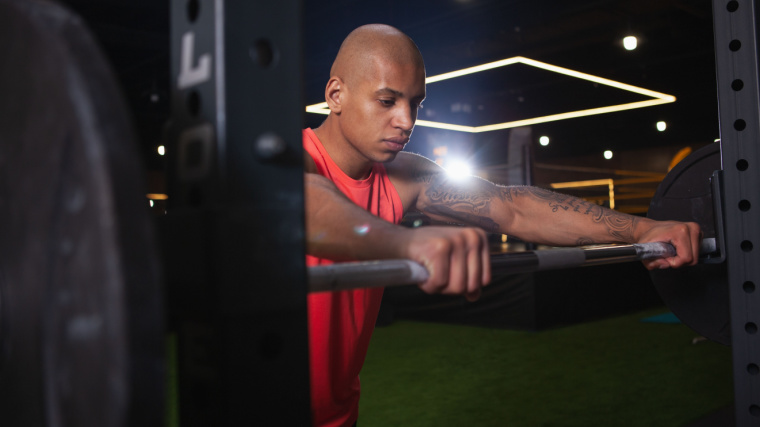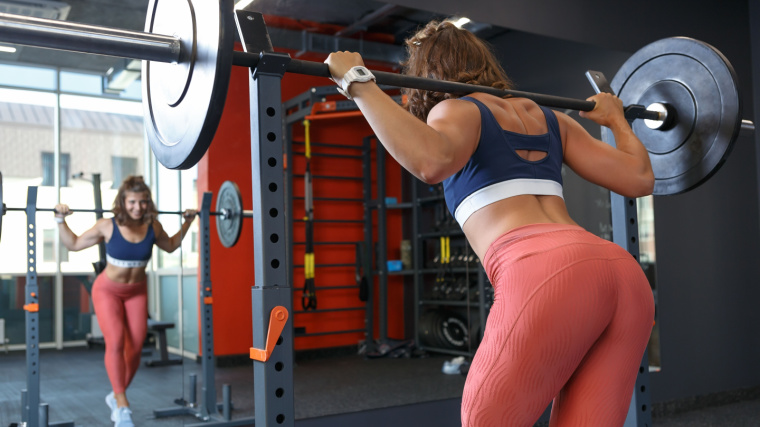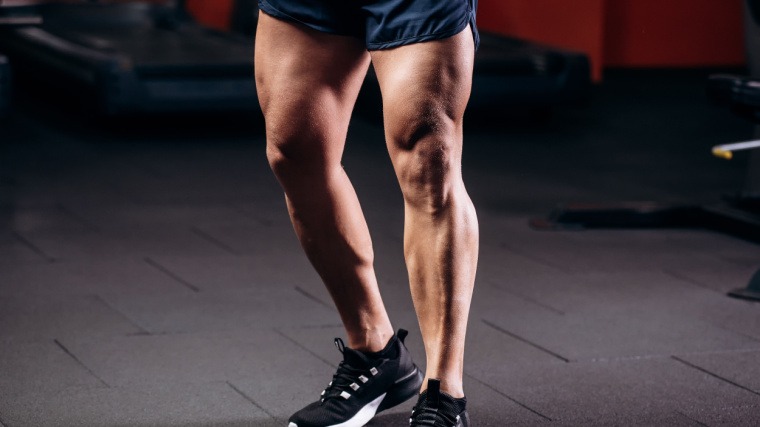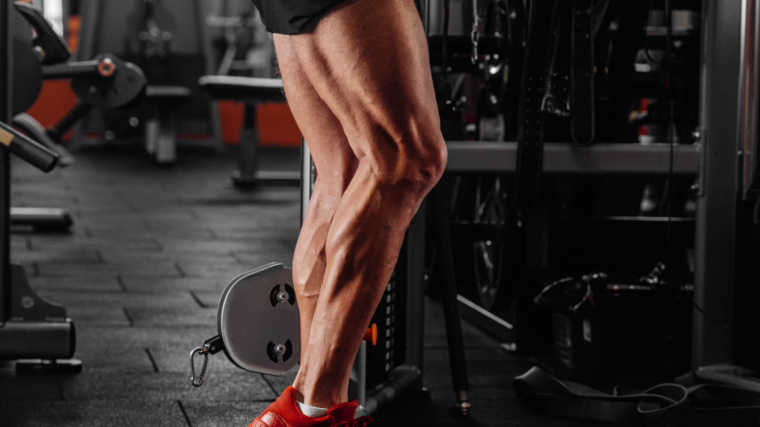The back squat, universally hailed the king of leg exercises, holds a timeless place in the realm of strength training. It’s a basic barbell movement that challenges not only your physical strength, but mental strength as well.
The reason it is such a tough exercise to conquer has to do with not just muscular power, but muscular coordination, as well. (1) When you perform the classic barbell squat, you’re recruiting multiple muscle groups at the same time, from head to toe, while coordinating your effort amongst the physical and technical demands of the exercise.
While many exercises can have their place in a leg workout, if you’re seeking to enhance the muscular density and strength of your lower body, the back squat is the undisputed champion. It puts your muscles to the test, as it demands a level of metabolic dedication that’ll trigger a spike in growth hormone that plays a role in stimulating hypertrophy. (2)
Take a closer look and focus on the mechanics of the squat, the muscles recruited, and some simple and effective variations that can help you get the most out of the time-tested back squat.
What Muscles Do Squats Work?
How to Do the Squat— A Technique Guide
The barbell back squat can appear deceptively simple at first — put the bar on your back, squat down, and stand up. However, there are many details to this lift that can often be overlooked, such as specific bar placement, hand and foot position, and the posture of your head and neck.
Here’s a step-by-step guide to performing the squat, along with some tips to become a better squatter. Safety is crucial. Make sure to apply all of these steps for every individual repetition to not only get stronger, but to train smarter, too.
Step One — Set the Barbell Height
Set the barbell at shoulder-height in a squat rack. When you grip the bar, position your arms parallel to the ground, ensuring a comfortable grip width that suits your shoulder mobility. Starting with a shoulder-width grip is recommended, but adjust to your individual balance of mobility and stability.

Coach’s Tip: If you encounter difficulties with your shoulder mobility, perform a thorough upper-body warm-up before starting your leg workout to improve your shoulder and chest mobility.
Step Two — Position the Bar and Create a Shelf
Choose between using either a high bar or low bar placement. What deciphers between a high bar or low bar position is whether the barbell is above your rear deltoids, or on top of (or below) your rear deltoids.
A high-bar squat tends to emphasize the knee joint which would recruit more quadricep dominance than a low-bar squat, which would place the weight closer to the hip joint to recruit the glute muscles. Select the bar placement that aligns with your training goals.

“Building a shelf” helps to create a space for the barbell to sit comfortably on the upper back to squat. To build a shelf, retract your scapulae (shoulder blades) and tighten your upper back to create a stable shelf for the bar to rest on.
Ensure your elbows are positioned underneath the bar, further securing it and promoting better posture. If your elbows aren’t under the bar or near perpendicular to the floor, your upper back might lose tightness and cause your spine to bend forward.
Coach’s Tip: To help keep your elbows underneath the bar, explore your grip width on the bar. The wider the grip, the more mobility your shoulder will have to support this aspect of your squatting performance.
Step Three — Unrack the Weight and Set Your Stance
Lift the barbell off the J-hooks and take two steps back. If you’ve set your barbell height correctly, it should be relatively easy to unrack the weight. When stepping back, keep the initial step small, as the second step is primarily used to adjust your stance. Avoid stepping too far back, as this will make it more challenging to re-rack the weight later.
Your stance significantly influences muscle engagement. For a more quadriceps-focused squat, opt for a closer stance with your toes forward or slightly outward. Athletes should keep their feet forward to mimic the stance of their specific sport. (3)
If you are looking for maximum squat strength, angle your toes slightly outward to make sure your knees stay outward in a more advantageous position. If you want to engage your hips more, stand wider and turn your toes outward — a technique often used by powerlifters and strongman competitors.
Coach’s Tip: The strongest and relatively biggest muscles of the body are your glutes. If you want to maximize strength, you want to use a more “glute-dominant” variation of the squat. Make sure your feet are a little wider than a normal stance, with your toes outward. Consider using a low-bar position, as well.
Step Four — Head Position
To maintain a flat and rigid spine throughout the squat, make sure you position your head slightly down at roughly a 45-degree angle. This head placement helps flatten the cervical spine — the vertebrae of your neck — which helps influence the rest of your spine to remain stable during the lift.
Coach’s Tip: If you struggle to have good posture, start off with your head slightly facing down, but, as you perform the squat, keep your head slightly forward until you hit your sticking point moving upward. Once you hit that sticking point, tilt your head up and forward to help influence your spine to “get taller.” This should put you in a better position and improve your squat.
Step Five — Time to Squat
After the detailed process of setting up in a good position, it’s time to perform the squat itself.
- Initial Phase: Before beginning the descent, brace your core by taking a deep breath through your belly, increasing pressure within your abdominal cavity. This technique enhances lower back rigidity and overall posture. Consider using a lifting belt for added support. To keep the brace in your core, breathe through your nose, and do not allow your shoulders to rise during your initial breath.
- Descending Phase: As you lower into the squat, ensure your hips move downward and slightly back to distribute the weight evenly across your mid-foot. The goal is to maintain proper alignment between your knee and hip joints. Aim to reach a comfortable depth, with your thighs near parallel to the ground or slightly lower.
- Ascending Phase: During the ascent, pay attention to potential “sticking points” as the load gets heavier. When your strength gets challenged, technique becomes crucial. The better your technique is from start to finish, the more likely you can battle through that sticking point to complete the lift. Return upright to a full lockout.
By following each of these steps and maintaining proper form throughout the movement, you’ll maximize head-to-toe muscle engagement and reduce the chances of common mistakes, ensuring a successful and effective squat.
Muscle Recruitment During Squats
Time to dig deep into the anatomy of the barbell back squat, exploring the primary muscles and secondary muscles required to perform the movement.
The barbell back squat recruits a combination of primary and secondary muscles, with the quadriceps and glutes taking the lead in knee and hip extension, respectively. Proper engagement of these muscle groups, and the support of secondary muscles, is crucial for executing a safe and effective squat.
Primary Muscles
A primary muscle is the main targeted muscle used during an intended movement. The muscles tend to be the larger muscles of the anatomy, especially during a compound movement which involves moving at multiple joints — in the squat, you’re moving at the hips, knees, and ankles. The primary muscles of the squat are the quadriceps and the glute maximus.

Quadriceps
- The quadriceps are a group of four muscles located at the front of the upper leg.
- The primary function of the quadriceps is knee extension, which is crucial during the ascending phase of the squat. They play a pivotal role in straightening the knee joint as you lift the weight.
- The quadriceps are heavily engaged when an athlete relies on their knee joint to move the weight. The knee joint might be prioritized during a high-bar squat, a squat to full (below parallel) depth, or when the athlete’s knees begin to break far in front of their toes.
Glutes
- The gluteus maximus, the largest of the gluteal muscles, forms the bulk of the hip joint.
- The glutes are responsible for hip extension, which is crucial for rising from a squat position. They provide the power needed to straighten the hips.
- The gluteus maximus is heavily engaged when an athlete starts to rely more on their hip joint to drive the weight up. The hip joint might be prioritized when an athlete performs a low-bar squat, box squat, or when the athlete has “vertical shins,” which means they are putting more weight on their heels than their toes.
Secondary Muscles
A secondary muscle tends to be a relatively smaller muscle group that aids the primary muscle(s) with executing an exercise. The secondary muscles that provide support and stabilization during the squat are the hamstrings, calves, lower back, and core muscles.

Hamstrings
- The hamstrings are located at the back of your upper leg, running from your hips to you knees.
- While primarily responsible for knee flexion (like leg curls), the hamstrings assist in hip extension (straightening your upper leg in line with your torso). Your hamstrings help control the descending phase of the squat, acting as stabilizers.
Calves
- The calves are comprised of the gastrocnemius and soleus muscles, and are located behind your lower leg.
- The primary function of the calf muscles is the extension of the ankle joint — “pointing” your foot down. While not directly involved in the squat, they help stabilize the ankle joint, especially when pushing through the mid-foot. If you want to have a great squat, you want to keep your feet flat during each rep, meaning you need great ankle mobility, which relies on flexible calf muscles.
Erector Spinae (Lower Back)
- The erector spinae muscles run along your spine’s length, supporting and stabilizing your lower back, especially.
- The erector spinae muscles are responsible for spinal extension, helping to maintain an upright torso position during the squat.
Core
- Your core includes muscles such as the rectus abdominis, obliques, and transverse abdominis.
- Core muscles provide stability to the torso, helping maintain proper posture and preventing excessive spinal flexion or extension. They work in conjunction with the erectors, as well.
How to Emphasize Key Muscles
As mentioned earlier, the primary muscles used to squat are the quadriceps and the glutes. However, to emphasize one muscle group over the other depends on adjusting your setup and movement, including foot placement, stance, depth, and barbell placement. (4)
Maximizing Quadriceps Recruitment
For those seeking to grow and strengthen their quadriceps, start by positioning your feet closer together, either at shoulder-width or slightly narrower. This narrower stance magnifies the involvement of your quadriceps during the squat, intensifying their engagement.
To further emphasize quadriceps recruitment, favor a high-bar placement with the barbell on your upper back. Placing the bar higher on your back shifts your center of gravity forward, ensuring that your quadriceps take the brunt of the load.
This strategic bar placement is a key element in effectively targeting and strengthening the quadriceps, especially for those in a hypertrophic (muscle-building) phase of training.
Another trick toward quad-dominance is going below a parallel depth. This increased depth tends to cause the shins to lean forward, putting the ankle within a great range of motion (also known as “dorsiflexion”) which will put more strain on the knee joint. This causes the quadriceps to be more activated.
Maximizing Glute Recruitment
If your objective centers on maximizing glute engagement, widen your stance beyond a shoulder-width position and point your toes out. This can influence your shins to stay upright, redirecting the focus to your glutes and intensifying their involvement.
You should also use a low-bar position to shift the weight distribution at your hip joints. This helps you get a better hip hinge, which accentuates glute recruitment. Placing the bar lower on your back ensures that the glutes play a more dominant role in the squat.
For those who struggle with feeling glute recruitment, try including a “pause” in the bottom position, or even use a box squat variation, as the box enforces the cue to push your hips backward instead of down. That’s a key point— if your hips move further back, your glutes can be more engaged.
Squatting straight down pushes your upper thighs forward as you descend, causing your knees to be more recruited, which would cause a more quadriceps-dominant action.
Squat Variations
There are a few other squat variations that can be used to further emphasize recruitment of either your quadriceps or glutes. By making changes to the bar position or, in some cases, avoiding the standard barbell completely, you can force your body to recruit different muscles while performing the same fundamental squatting movement.
Front Squat
In this variation, the barbell is positioned on the front of your shoulders rather than across your upper back. To achieve this unique position, you can either cross your arms over each other to hold the barbell or use an Olympic weightlifting-style “rack” position that puts your arms parallel to each other with your arms bent and the bar near your fingertips.
The defining feature of the front squat is its demand for a more upright torso posture. This is what would make the movement more quadriceps-dominant than glute-dominant, similar to a high-bar squat.
The front squat promotes improved posture and spinal alignment. It strengthens your upper back while reducing the risk of forward-leaning tendencies often associated with the classic barbell back squat.
SSB Squat
The SSB (safety squat bar) is a specialized barbell that has pads and forward-pointing handles that hold the weight on top of your shoulders and upper back. The weight distribution creates a forward-leaning upper body angle compared to a standard barbell , which significantly impacts the mechanics of the squat. This makes it a more quadriceps-dominant variation.
The SSB squat is an ideal choice for individuals who may have mobility limitations in certain areas like the shoulders. Additionally, the SSB squat places a substantial focus, not only on the quadriceps, but also the upper back and the posterior chain. It delivers a great challenge to not just quadriceps strength, but postural strength as well.
In terms of muscle engagement, the primary target during the SSB squat is your quadriceps. However, the angled handles also bring your upper back and posterior chain into play. This shift in muscle emphasis sets it apart from the classic barbell back squat, which primarily targets the quadriceps but doesn’t engage the upper back and posterior chain to the same extent.
Belt Squat
The belt squat is unlike the front squat or SSB squat. Instead of placing a barbell on your upper body, you wear a belt around your waist attached either to a specially designed platform or to a barbell on the ground set in a landmine unit. The belt distributes weight across your hips, which makes it a glute-dominant variation of the barbell squat.
The belt squat offers an effective means of challenging the lower body without placing weight on your torso and spine, making it particularly suitable for individuals dealing with back issues.
Additionally, the belt squat targets your legs with little to no upper body involvement. This would be a great exercise for those with specific limitations, including poor shoulder mobility, spinal compression issues, or an inability to hold a barbell with one or both arms.
Time to Squat
The barbell back squat is a top exercise that engages multiple muscle groups and delivers massive benefits, from increasing strength and power to building more muscular legs. Overall muscle recruitment during squats is a crucial variable that can be manipulated by your stance, movement, and bar position. No matter how you do it, the squat is an iconic lift that can improve anyone’s success in building size, strength, and athleticism.
References
- Myer, G. D., Kushner, A. M., Brent, J. L., Schoenfeld, B. J., Hugentobler, J., Lloyd, R. S., Vermeil, A., Chu, D. A., Harbin, J., & McGill, S. M. (2014). The back squat: A proposed assessment of functional deficits and technical factors that limit performance. Strength and conditioning journal, 36(6), 4–27. https://doi.org/10.1519/SSC.0000000000000103
- Wilk, M., Petr, M., Krzysztofik, M., Zajac, A., & Stastny, P. (2018). Endocrine response to high intensity barbell squats performed with constant movement tempo and variable training volume. Neuro endocrinology letters, 39(4), 342–348.
- Ribeiro, Alex & Santos, Erick & Nunes, João Pedro & Amarante do Nascimento, Matheus & Graça, Ágatha & Bezerra, Ewertton & Mayhew, Jerry. (2022). A Brief Review on the Effects of the Squat Exercise on Lower-Limb Muscle Hypertrophy. Strength and Conditioning Journal. Publish Ahead of Print. 10.1519/SSC.0000000000000709.
- Larsen, S., Kristiansen, E., Helms, E., & van den Tillaar, R. (2021). Effects of Stance Width and Barbell Placement on Kinematics, Kinetics, and Myoelectric Activity in Back Squats. Frontiers in sports and active living, 3, 719013. https://doi.org/10.3389/fspor.2021.719013
Featured Image: MilanMarkovic78 / Shutterstock
Trending Products














